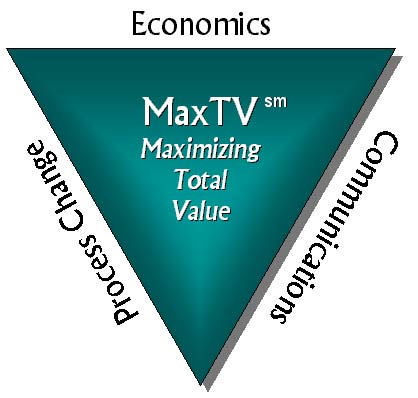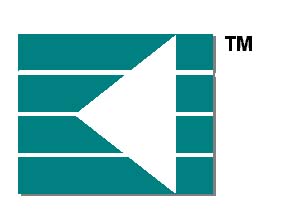for Speedy Sales Sales & Successful Systems
Just as Noel Coward once described British and Americans as a people divided by a common language, so might technology vendors and their customers be characterized as organizations divided by a common purpose. Specifically, both parties share the single goal of maximizing the total value a high-tech solution provides. But they do so for different reasons:
- Vendors want to sell their products and services as quickly and efficiently as possible.
- Customers want to improve operations to the greatest degree and for the least cost possible.
Beyond ROI and TCO Lies
MaxTV®!
This disconnect is rooted in the
micro-focus many customers place on the out-of-pocket costs associated
with acquiring and implementing a new system. Goaded by press news clippings
and analyst sound bites, they lock too often onto return on investment (ROI)
and total cost of ownership (TCO) as key measures of system value.
But as valuable as these benchmarks
are, they do not address two other factors that are equally critical to
a successful implementation. For example, how do you assign a dollar value
to helping customers propagate new business procedures or communicate new
ideas across many departments? These abilities rank high on CIOs lists
of strategic objectives, yet rarely receive focused attention until the
sales cycle is well along
and then cause the entire process to grind
to a halt.
x
 In
truth, the total value a system provides exists on three levels: economics,
process change, and communications (see figure). Your real goal, therefore,
is not merely to score high on an ROI/TCO test, but to help customers optimize
the impact your product will have on the other two factors as well. At
the end of the day, customers want to receive Maximum Total Value MaxTV®
and if you can give it to them, you should be able to close more sales
more quickly, and empower customers to meet their improvement goals.
In
truth, the total value a system provides exists on three levels: economics,
process change, and communications (see figure). Your real goal, therefore,
is not merely to score high on an ROI/TCO test, but to help customers optimize
the impact your product will have on the other two factors as well. At
the end of the day, customers want to receive Maximum Total Value MaxTV®
and if you can give it to them, you should be able to close more sales
more quickly, and empower customers to meet their improvement goals.
Inside the Elements
MaxTV®
may be best thought of as a contextual wrapper to a lot of solid work that
has come before. It provides a holistic perspective on the value being
provided by what otherwise is a patchwork quilt of technology systems.
Briefly, the three elements of MaxTV®
break down as follows:
- Economics encompasses both ROI and TCO, and is by far the most easily quantified and perhaps thus the best understood -- of the MaxTV® elements. Many vendors (SAP and PeopleSoft, to name just two) have developed ROI models to support their sales activities and are finding them to be quite effective.
- Process Change encompasses reengineering and quality management and has at its heart the ability to support both discrete process innovation and continuous process improvement. The concepts here are fairly well proven and lie at the heart of products from companies like Meta Software and Visio.
- Communications encompasses customer relationship management and learning/knowledge. The philosophies here are rooted in facilitating collaboration and satisfaction among employees, customers, and business partners, who must work effectively together for an organization to thrive. Vendors active in this arena include Lotus Development, Siebel Systems, and many companies in and around the messaging and ERP market spaces.
Typically, customers dont realize just how hard it is to maximize the value they receive from the systems theyre exploring. At first, they may enthuse over the efficiencies they think the new system will provide. But they soon realize the enormity of the technical integration and change management tasks that await them. And when they do, they retrench and reconsider, and cause an air bubble to appear in the sales pipeline.
Six eight ten months later, customers finally perceive themselves as being ready to move ahead, and they return to the bargaining table. Meanwhile, the vendor is left cooling its heels, trying various tricks to keep the process moving but mostly just staying visible so the conversation can resume when the customer returns.
The goal, of course, is to compress or eliminate the bubble by helping customers work through their issues as quickly as possible. Ideally, this would be accomplished right at the beginning as part of the needs assessment activity. By working early with customers to prioritize their objectives, you could immediately begin demonstrating how effectively your offerings can return maximum value. And since dealing with these issues up front means they wont surprise anyone later on, such a strategy should measurably shorten the overall sales cycle.
Conclusion
The bottom line is that customers
are waking up to the fact that system value involves more than ROI and
TCO. And as they do, they will demand that their vendors speak to MaxTV®
and offer them the means to reconcile their economic, process, and communications
needs. Vendors that do so stand to grow in the years ahead even despite the present economic condition. Those that dont may find themselves stuck in their current rut, or worse, nothing but a fading memory.

 Kinetic
Information Home
Kinetic
Information Home